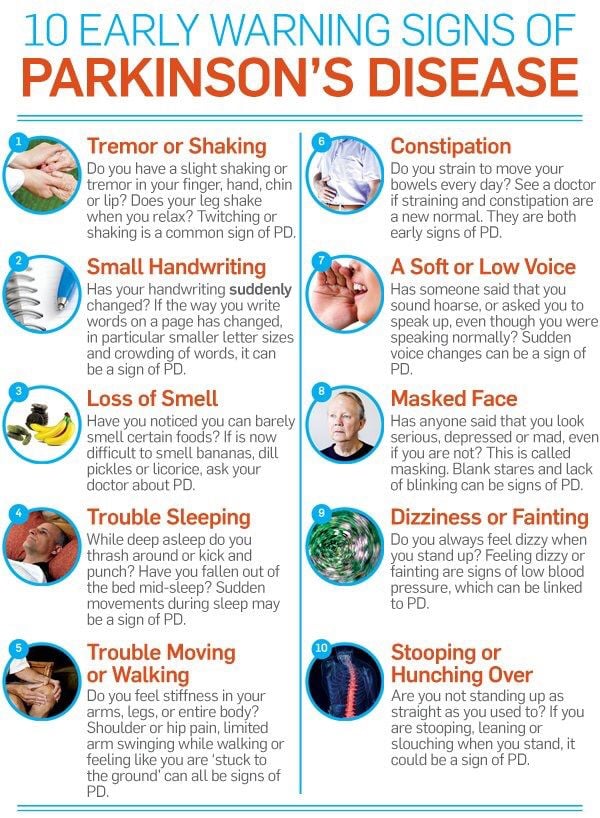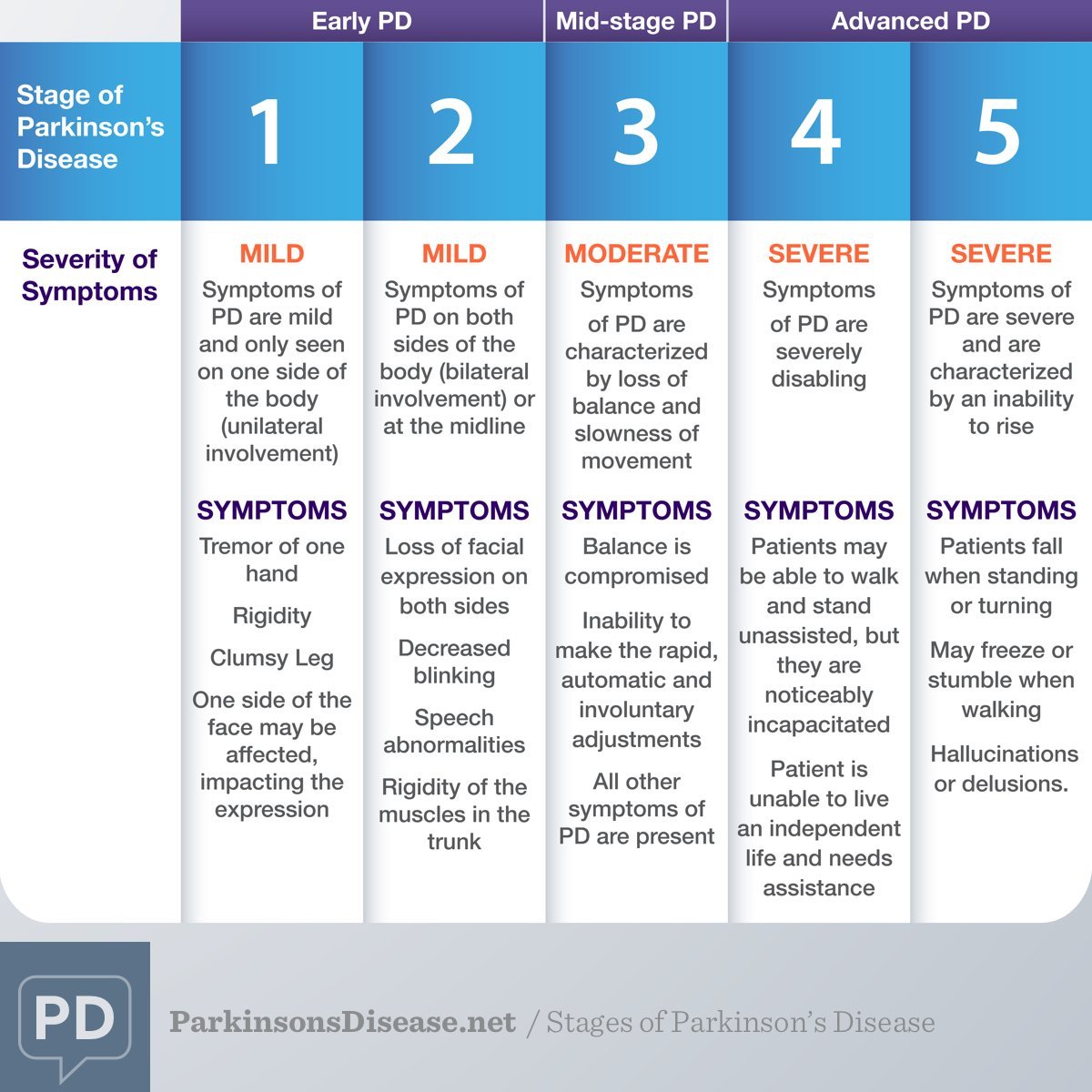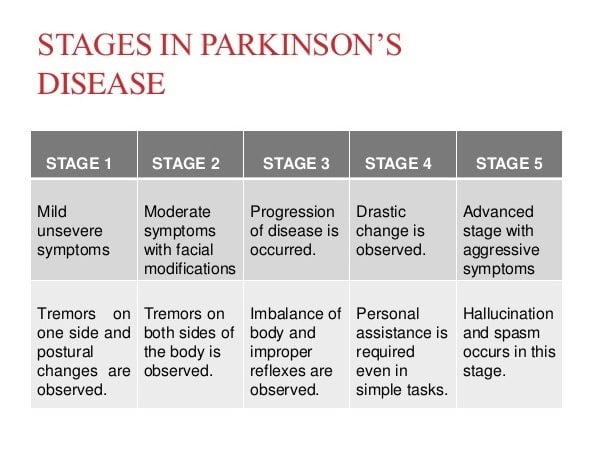How Are The Different Stages Of Parkinsons Treated
Treatment for Parkinsons depends on the severity of the symptoms. In the early stages, prescription medication may be enough to treat more mild symptoms. A 2019 review published in the journal Biomolecules listed some of the main pharmacological treatments for motor and non-motor symptoms for each stage of Parkinsons disease.
The main pharmacological treatments include medications such as l-dopa, a precursor to dopamine that crosses the blood-brain barrier to increase dopamine transmission, clonazepam or melatonin for REM sleep behavior disorder, and SSRIs or SNRIs for depression, which is a common non-motor symptom for Parkinsons. About 50% of people with Parkinsons experience depression.
L-dopa is the most effective and most prescribed medication for Parkinsons. Although it doesnt slow the progression of the disease or cure it, it can help control movement symptoms such as slow movement , rigidity, and tremors. However, one of the side effects of l-dopa is dyskinesia, strange, jerky movements that cant be controlled. You might decide to hold off on starting l-dopa if your symptoms are not getting in the way of your daily life.
Additional treatments for Parkinsons may include medications like dopamine agonists and monoamine oxidase inhibitors, and non-pharmacological treatment like physical therapy and speech therapy.
Parkinson’s Disease Symptoms: Life Expectancy
Even though Parkinson’s disease is a serious, progressive condition, it is not considered a fatal illness. People who have Parkinson’s disease usually have the same average life expectancy as people without the disease.
But when the disease is in its advanced stages, Parkinson’s symptoms can lead to life-threatening complications, including:
- Falls that lead to fractured bones
- Pneumonia
- Choking
Thinking about the progression of Parkinson’s disease can be frightening. But proper treatments can help you live a full, productive life for years to come. And researchers hope to one day find ways to halt the progression of Parkinson’s and restore lost functioning.
How Is Parkinsons Diagnosed
Your primary care physician can make a diagnosis of Parkinsons based on your symptoms, but many choose to see a neurologist who specializes in movement disorders. During your examination, your doctor will check for balance and movement issues. To make a Parkinsons diagnosis, you have to exhibit two of the four symptoms for an extended period of time.
- Tremors
- Stiffness or rigidity in the arms, legs or core
- Balance issues
Also Check: Prayers For Parkinson’s Disease
What Can You Do If You Have Pd
- Work with your doctor to create a plan to stay healthy. This might include the following:
- A referral to a neurologist, a doctor who specializes in the brain
- Care from an occupational therapist, physical therapist or speech therapist
- Meeting with a medical social worker to talk about how Parkinson’s will affect your life
For more information, visit our Treatment page.
Page reviewed by Dr. Chauncey Spears, Movement Disorders Fellow at the University of Florida, a Parkinsons Foundation Center of Excellence.
How Fast Does Parkinson’s Disease Progress

People tend to move through the Parkinson’s disease stages slowly, usually over the course of years. Research has shown that the disease tends to progress less rapidly in people who are diagnosed at a younger age than those diagnosed later in life.
What’s more, Parkinson’s disease may begin decades before a patient even notices a single motor symptom.
“We know that Parkinson’s disease actually starts many, many years before you see that tremor or that shuffling,”Lynda Nwabuobi, MD, assistant professor of clinical neurology at Weill Cornell Parkinson’s Disease and Movement Disorders Institute, tells Health. “We think at least 30 years.”
Don’t Miss: Weighted Silverware
What Are The Different Stages Of Parkinsons Disease
Each person with Parkinsons disease experiences symptoms in in their own unique way. Not everyone experiences all symptoms of Parkinsons disease. You may not experience symptoms in the same order as others. Some people may have mild symptoms others may have intense symptoms. How quickly symptoms worsen also varies from individual to individual and is difficult to impossible to predict at the outset.
In general, the disease progresses from early stage to mid-stage to mid-late-stage to advanced stage. This is what typically occurs during each of these stages:
Early stage
Early symptoms of Parkinsons disease are usually mild and typically occur slowly and do not interfere with daily activities. Sometimes early symptoms are not easy to detect or you may think early symptoms are simply normal signs of aging. You may have fatigue or a general sense of uneasiness. You may feel a slight tremor or have difficulty standing.
Often, a family member or friend notices some of the subtle signs before you do. They may notice things like body stiffness or lack of normal movement slow or small handwriting, lack of expression in your face, or difficulty getting out of a chair.
Mid stage
Mid-late stage
Standing and walking are becoming more difficult and may require assistance with a walker. You may need full time help to continue to live at home.
Advanced stage
Another Tool For Tracking Parkinsons Progression
Some neurologists also use the Unified Parkinsons Disease Rating Scale to track the symptoms of PD. The UPDRS is a more extensive tool that also checks nonmotor symptoms of Parkinsons, such as:
- Mental function
- Lightheadedness upon standing
- Fatigue
Members of MyParkinsonsTeam have discussed a wide range of experiences when it comes to how their condition progresses. I was diagnosed with PD in 2003, and my symptoms did not advance significantly until 2019, one member wrote. Another said, My PD has advanced slowly and I feel pretty good most of the time.
Don’t Miss: Does Vitamin B12 Help Parkinson’s
Do People Actually Lose Their Sense Of Smell With Parkinson’s
A: Yes. It’s a condition called anosmia, and if you have it with no other disease , you have at least a 50 percent chance of developing Parkinson’s disease in the next five to 10 years. What happens is that alpha-synuclein, the protein that clumps in the part of the brain that regulates dopamine and leads to Parkinson’s disease, also aggregates in the olfactory bulb, the part of the brain responsible for your sense of smell. This happens well before the protein accumulations cause motor symptoms.
How Is Parkinsons Disease Treated
There is no cure for Parkinsons disease. However, medications and other treatments can help relieve some of your symptoms. Exercise can help your Parkinsons symptoms significantly. In addition, physical therapy, occupational therapy and speech-language therapy can help with walking and balance problems, eating and swallowing challenges and speech problems. Surgery is an option for some patients.
Read Also: Sam Waterston Tremor
How Common Is Cognitive Decline In Parkinsons
A new study finds that cognitive impairment is a frequent and rapidly progressing symptom of Parkinsons disease . About half of the participants who had PD for an average of five years and had normal cognition at the beginning of the study developed mild cognitive impairment within six years about 11 years after PD diagnosis. Those few who developed MCI progressed to dementia within five more years. The results appear in the September 11 online edition of Neurology.
With a diagnosis of PD, most people and their physicians focus on treating and coping with movement symptoms. Yet even early in the course of disease, people with PD may have difficulty multitasking, or feel that their thinking abilities are just not the same.
To better understand the rate at which cognitive impairment develops, and identify risk factors for the development of cognitive impairment, researchers led by Daniel Weintraub, M.D., recruited 141 people with PD to participate in the study. All were receiving treatment at the University of Pennsylvanias Udall Center for Parkinsons Disease Research. On average they were 69 years old and had been living with PD for five years 63 percent were men. All participants had normal cognition based on a battery of standard tests for people with PD. The researchers re-evaluated study participants cognition each year for up to six years.
Results
What Does It Mean?
Reference
What Causes Parkinsons Disease
Parkinsons disease occurs when nerve cells in an area of the brain called the substantia nigra become impaired or die. These cells normally produce dopamine, a chemical that helps the cells of the brain communicate . When these nerve cells become impaired or die, they produce less dopamine. Dopamine is especially important for the operation of another area of the brain called the basal ganglia. This area of the brain is responsible for organizing the brains commands for body movement. The loss of dopamine causes the movement symptoms seen in people with Parkinsons disease.
People with Parkinsons disease also lose another neurotransmitter called norepinephrine. This chemical is needed for proper functioning of the sympathetic nervous system. This system controls some of the bodys autonomic functions such as digestion, heart rate, blood pressure and breathing. Loss of norepinephrine causes some of the non-movement-related symptoms of Parkinsons disease.
Scientists arent sure what causes the neurons that produce these neurotransmitter chemicals to die.
Recommended Reading: On-off Phenomenon
What Is The Outlook For Persons With Parkinsons Disease
Although there is no cure or absolute evidence of ways to prevent Parkinsons disease, scientists are working hard to learn more about the disease and find innovative ways to better manage it, prevent it from progressing and ultimately curing it.
Currently, you and your healthcare teams efforts are focused on medical management of your symptoms along with general health and lifestyle improvement recommendations . By identifying individual symptoms and adjusting the course of action based on changes in symptoms, most people with Parkinsons disease can live fulfilling lives.
The future is hopeful. Some of the research underway includes:
- Using stem cells to produce new neurons, which would produce dopamine.
- Producing a dopamine-producing enzyme that is delivered to a gene in the brain that controls movement.
- Using a naturally occurring human protein glial cell-line derived neurotrophic factor, GDNF to protect dopamine-releasing nerve cells.
Many other investigations are underway too. Much has been learned, much progress has been made and additional discoveries are likely to come.
How Do I Prevent Falls From Common Hazards

- Floors: Remove all loose wires, cords, and throw rugs. Minimize clutter. Make sure rugs are anchored and smooth. Keep furniture in its usual place.
- Bathroom: Install grab bars and non-skid tape in the tub or shower. Use non-skid bath mats on the floor or install wall-to-wall carpeting.
- Lighting: Make sure halls, stairways, and entrances are well-lit. Install a night light in your bathroom or hallway and staircase. Turn lights on if you get up in the middle of the night. Make sure lamps or light switches are within reach of the bed if you have to get up during the night.
- Kitchen: Install non-skid rubber mats near the sink and stove. Clean spills immediately.
- Stairs: Make sure treads, rails, and rugs are secure. Install a rail on both sides of the stairs. If stairs are a threat, it might be helpful to arrange most of your activities on the lower level to reduce the number of times you must climb the stairs.
- Entrances and doorways: Install metal handles on the walls adjacent to the doorknobs of all doors to make it more secure as you travel through the doorway.
Don’t Miss: Voice Amplifiers For Parkinson’s
Why Is There A Delay
Parkinsons disease is a slow, progressive condition, said Simonet. We do not expect all symptoms to start at once from one day to another.
According to Simonet, there is a pre-diagnostic phase when the motor symptoms and non-motor symptoms of Parkinson’s emerge over time.
The researchers did suggest one possible reason for the delay in diagnosis.
Even if patients have classic signs of Parkinsons like tremors and memory problems, providers may have a harder time evaluating symptoms in patients from traditionally under-represented groups.
What Are Home Remedies For Parkinson’s Disease
Treatment for Parkinson’s disease may include medications, surgery, gene therapy, other therapies, or a combination of these.
The decision to care for a family member with Parkinson’s disease is very complex.
Some patients’ treatment will include or begin with medications to “protect” the neurons that make dopamine. Although “neuroprotective agents” protect cells in tissue cultures, it is not clear if they have the same effect on patients’ neurons. These medications are monoamine oxidase B inhibitors .
Occasionally, some doctors may prescribe amantadine for short-term treatment of early Parkinson’s disease symptoms or use the medication in conjunction with carbidopa-levodopa treatment.
Patients usually will be given medications at the lowest effective dose. Over time, the various medication effects often diminish. To minimize medication side effects, the doctor may slowly increase dosages. Side effects involving problems with thinking are relatively common in older patients.
Don’t Miss: Diseases Similar To Parkinsons
How Early Can Parkinson’s Disease Be Diagnosed
A: A true determination of Parkinson’s disease is a clinical diagnosis, which means certain motor symptoms have to be present, but we now know more about some early signs of Parkinson’s disease that, while they don’t always lead to the condition, are connected.
In terms of how early we can detect, we can detect a mutation that is associated with an increased risk of Parkinson’s as early as birth. In the minority of patients who may have a known Parkinson’s-related genetic mutation , that gene could be tested for at any time in life. At the same time, that’s not diagnosing Parkinson’s it’s just identifying the risk.
Early warning signs are what we call prodromal, or preclinical, symptoms. Prodromal symptoms are an early warning sign that someone might get Parkinson’s disease. Though some of these symptoms have a very high probability of signaling future Parkinson’s, having one or more of them is still not a 100 percent probability. Some prodromal symptoms are loss of sense of smell, REM behavior disorder, anxiety or depression, and constipation.
Why East London
The researchers chose East London for their study because of its diverse, racially mixed population, in contrast to other studies of Parkinsons that have been conducted in largely White populations.
East London is about 45% Black, South Asian , or mixed race, compared to 14% of the U.K. as a whole.
Since the U.K. has its National Health Service , everyone in East London has access to healthcare. Therefore, a patients economic status is not a factor when seeking or receiving treatment.
Don’t Miss: Sam Waterston Parkinson’s
What You Can Do
As of 2021, there is no definite cure for Parkinsons disease. There is also no definite known cause. Its likely due to a combination of an individuals susceptibility and environmental factors. Most cases of Parkinsons disease happen without a genetic link.
According to research published in 2012, only report having a family member with the disease. Many toxins are suspected and have been studied, but no single substance can be reliably linked to Parkinsons.
However, research is ongoing. Its estimated that
What Makes Pd Hard To Predict
Parkinsonâs comes with two main buckets of possible symptoms. One affects your ability to move and leads to motor issues like tremors and rigid muscles. The other bucket has non-motor symptoms, like pain, loss of smell, and dementia.
You may not get all the symptoms. And you canât predict how bad theyâll be, or how fast theyâll get worse. One person may have slight tremors but severe dementia. Another might have major tremors but no issues with thinking or memory. And someone else may have severe symptoms all around.
On top of that, the drugs that treat Parkinsonâs work better for some people than others. All that adds up to a disease thatâs very hard to predict.
Also Check: Parkinson’s Bike Therapy
What Are The Non
Parkinson’s disease stages are defined by the severity of a patient’s motor symptoms and how much those symptoms impact one’s ability to function every day. But there are non-motor symptoms that are more likely to develop later in the disease, too, and a doctor may take those into consideration when assessing someone with the disorder.
For example, people with late-stage Parkinson’s disease might have difficulty chewing, eating, speaking, or swallowing , which is considered both a motor and non-motor symptom. Dysphagia in particular can lead to serious health problems like malnutrition, dehydration, and aspiration.
In the final stages of Parkinson’s disease, a person might develop cognitive changes, including slowness of memory or thinking, trouble planning and accomplishing tasks, and difficulty concentrating. Or they might notice changes in their bone health or vision.
But there’s no telling for sure if or when these symptoms will occur in any individual because Parkinson’s disease symptoms vary from person to person.
Understanding The Progression Of Parkinsons Disease

- The Parkinsons disease staging system is a helpful tool to track movement-related symptoms and to monitor disease progression.
- People with advanced Parkinsons disease are typically in stages 4 or 5, at which point symptoms have become severe and limiting.
- Effective treatment options are available for people with advanced Parkinsons disease.
Parkinsons disease is a neurological movement disorder that changes and often progresses the longer someone has it. There are several ways to assess and monitor disease progression of PD. One of those ways is to understand the five stages of Parkinsons.
It is important to note that everyone with PD experiences their own unique symptoms and disease progression. No two people will have the same Parkinsons journey. A person can develop advanced Parkinsons disease after many years, or they may experience a faster disease progression.
Recommended Reading: Fitflop Shoes For Parkinson’s